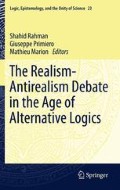Abstract
The distinction between realism and anti-realism about some topic is often couched in terms of the question of whether classical or intuitionist logic is applicable to it. Is paraconsistent logic realist or anti-realist? In this paper it is shown that the answer depends on the paraconsistent logic in question. This is done by discussing logics with constructible negation.
Access this chapter
Tax calculation will be finalised at checkout
Purchases are for personal use only
Notes
- 1.
- 2.
- 3.
See [6, §6.3].
- 4.
On all this, see [9, §9.7a].
- 5.
- 6.
In N 4, which we shall meet in the next section, the inference in both directions fails. The fact that ¬ A is true at a world does not entail that A is not true there.
- 7.
- 8.
- 9.
Rumfitt [12] argues for treating truth and falsity even-handedly, in the way required by N 3 and N 4. He does so by analysing falsity in terms of a primitive notion of rejection. This will do for N 3, but not for N 4, which would require one the be able to simultaneously accept and reject something.
- 10.
- 11.
- 12.
See [9, chap. 20].
- 13.
For a survey of paraconsistent logics, see [7].
- 14.
The * semantics for negation are very closely related to the relational semantics, and in simple cases are interdefinable with them. See [6, §9.6], and [9, §22.5]. One might therefore reasonably expect the considerations concerning the relational semantics to carry over to the * semantics. For one interpretation of the ternary relation in terms of information, and so broadly sympathetic to an anti-realist reading, see [2, chap. 3].
References
Almukdad, A., and D. Nelson. 1984. “Constructible Falsity and Inexact Predicates.” Journal of Symbolic Logic 49:231–33.
Mares, E. 2004. Relevant Logic: A Philosophical Interpretation. Cambridge: Cambridge University Press.
Nelson, D. 1949. “Constructible Falsity.” Journal of Symbolic Logic 14:14–26.
Papineau, D. 1979. Theory and Meaning. Oxford: Clarendon Press.
Priest, G. 1987. In Contradiction. Dordrecht: Martinus Nijhoff; 2nd (extended) Edition, Oxford: Oxford University Press, 2006.
Priest, G. 2001. Introduction to Non-Classical Logic. Cambridge, MA: Cambridge University Press; revised as Part 1 of G. Priest, Introduction to Non-Classical Logic: From If to Is (Cambridge: Cambridge University Press, 2008).
Priest, G. 2002. “Paraconsistent Logic.” In Handbook of Philosophical Logic, edited by D. Gabbay and F. Guenthner (2nd Edition), vol. 6, 287–393. Dordrecht: Kluwer.
Priest, G. 2006. Doubt Truth to Be a Liar. Oxford: Oxford University Press.
Priest, G. 2008. Introduction to Non-Classical Logic: From If to Is. Cambridge: Cambridge University Press.
Priest, G., and R. Routley. 1989. “The Philosophical Significance and Inevitability of Paraconsistency.” In Paraconsistent Logic: Essays on the Inconsistent, edited by G. Priest, R. Routley, and J. Norman, ch. 18. Munich: Philosophia Verlag.
Read, S. 1994. Thinking About Logic: An Introduction to the Philosophy of Logic. Oxford: Oxford University Press.
Rumfitt, I. 2000. “ ‘Yes’ and ‘No.’ ” Mind 109:781–823.
Wansing, H. 2001. “Negation.” In The Blackwell Guide to Philosophical Logic, edited by L. Goble, ch. 19. Oxford: Blackwell.
Acknowledgments
Versions of this paper were given at the Universities of Melbourne, St Andrews, and Lille in the second half of 2007. I am grateful to the audiences in those places for their helpful comments.
Author information
Authors and Affiliations
Corresponding author
Editor information
Editors and Affiliations
Rights and permissions
Copyright information
© 2012 Springer Science+Business Media B.V.
About this chapter
Cite this chapter
Priest, G. (2012). Realism, Antirealism, and Paraconsistency. In: Rahman, S., Primiero, G., Marion, M. (eds) The Realism-Antirealism Debate in the Age of Alternative Logics. Logic, Epistemology, and the Unity of Science, vol 23. Springer, Dordrecht. https://doi.org/10.1007/978-94-007-1923-1_10
Download citation
DOI: https://doi.org/10.1007/978-94-007-1923-1_10
Published:
Publisher Name: Springer, Dordrecht
Print ISBN: 978-94-007-1922-4
Online ISBN: 978-94-007-1923-1
eBook Packages: Humanities, Social Sciences and LawPhilosophy and Religion (R0)

